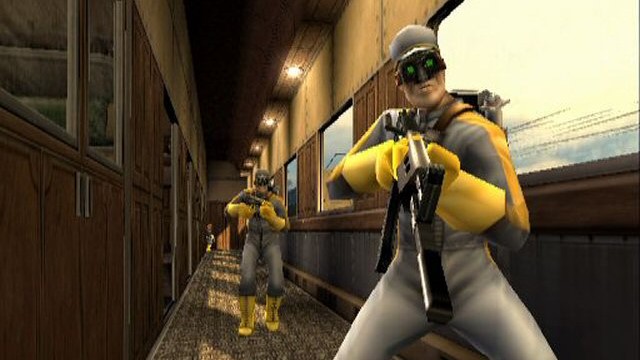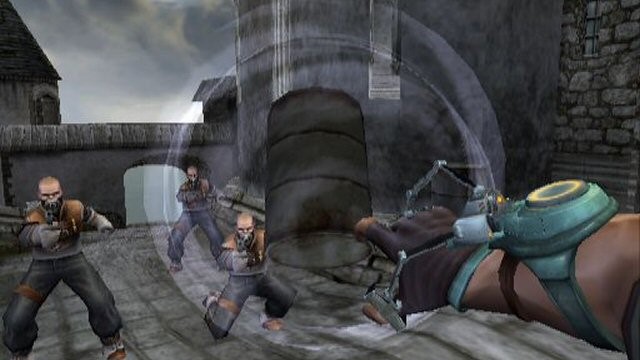TimeSplitters isn’t often recognized for its story. Intricate level design, innovative multiplayer, and a cast of goofy characters hallmark the franchise. But its third instalment, Future Perfect, had a distinctive overarching narrative at the heart of its time-jumping escapades that brought a new spin to the series. Typical of game development, this story wasn’t oven-ready on its first go.
A previously unreleased draft of Future Perfect’s story recently surfaced online. Written during the initial stages of the game’s development, the framework outlines the original plot, planned levels, and accompanying characters of its single-player campaign, detailing the exposition of each cutscene to provide an overview of its preliminary story. While some beats of this early draft match the final game, others reveal significant changes made in its writing process.
Gone are the time-loop sequences that form a recurring theme of Future Perfect’s story mode, and see protagonist Sergeant Cortez jump through a time portal mid-mission to help his past self. The draft makes no mention of these portals, time paradoxes or any of the intra-level time travel shenanigans that crop up throughout his adventure. Similarly absent are notable characters like the sardonic Mary-Beth Casey, who accompanies Cortez in the mansion level, and the game’s final boss.
Whole levels, including the prologue and two late-game missions, are missing from its roster, and many of their locations and dates differ from the final release. A host of mission plot points are different, too – the damsel in distress sequence in which the suave Harry Tipper rescues his partner from the nefarious Khallos isn’t included, and there’s no mention of the jarring supernatural ghosts that inhabit the mansion catacombs mission. Many recurring gags are also absent, including Cortez’s goofily endearing catchphrase – ‘It’s time to split!’
Offering a glimpse into the game’s creative alterations, we spoke about the draft with the games’ lead story writers, James Cunliffe and Andrew Lawson, to shed some light on the Future Perfect that could have been.
Organic and sporadic

The TimeSplitters brand was well established by the time Future Perfect began development. The first two titles had successfully carved-out its charming B-movie pastiche, and their penchant for myriad environments provided the foundation from which the franchise’s story could expand.
“When Future Perfect came up, we'd adopted this process that the level designers would decide what was interesting to them,” says Cunliffe. “They would say ‘I'm going to build this level’ and someone else would say ‘I'm going to build this level,’ and the task was given to me and Andrew to get this patchwork quilt and stick it together.”
"If you have a core mechanic for a game that you think is going to be fun and then you have to change it, you fundamentally change the terms of conflict for that experience. If the terms of conflict for that core experience end up being very different to the terms of conflict of your story, then you've got these two things that don't live in the same product."
James Cunliffe- Lead Story Writer
While some content was locked in from the beginning, including the Scottish island and haunted mansion levels, particulars were developed gradually. As new mission ideas, weapons, or gameplay sequences were brought in, the story was edited to implement these mechanics and provide appropriate exposition to justify their occurrence.
“It was constantly changing,” Lawson says about this interactive process. “We had to throw a ton of stuff out. We would have gags or things that we really liked that eventually, we couldn’t do because the game had to progress in this direction.”
The time-loop idea was one late addition. Although bursts of dual-Cortez team-ups are a staple of the final release, the idea was introduced independently of the main story writing. “Andrew and I would write and then inevitably six months later Dave [David Doak, the games co-director] would come to us and say, I want twice as much,” says Cunliffe. “This was one of those times. He was like, ‘look it's a game about time and there's no time travel gameplay in it, and it needs to have it.’”
As the team’s vision of the game coalesced, more specific plot details were added. The early story draft makes no mention of Cortez accidentally revealing the villain’s plans to his future self and sparking his malign deeds, nor includes the sequence of Cortez buddying up with four versions of himself simultaneously. Although the overall story had been refined by the time these details were decided, as self-contained plot points their inclusion wasn’t disruptive.
“That's game development,” says Cunliffe, about these sporadic additions. “It’s hard to start a project with this holistic vision of what the whole project is going to be because it requires everything to land.
“If you have a core mechanic for a game that you think is going to be fun and then you have to change it, you fundamentally change the terms of conflict for that experience. If the terms of conflict for that core experience end up being very different to the terms of conflict of your story, then you've got these two things that don't live in the same product.”
Right timing

Characters, too, were added spontaneously. While the draft has Cortez fight waves of TimeSplitters, the final release sees the villain mutate into a grotesque TimeSplitter hybrid for the final boss battle. These additions usually came from the haphazard contributions of lead character artist Ben Newman, who often put forward character designs that were unrelated to the planned story but too good to leave out.
“He would do these characters and on one hand I would think, wow, what an amazing character,” says Cunliffe. “And on the other hand I'd be panicking thinking how the hell am I going to write this into a cohesive story.”
"I don't think we had any consideration as to what the next thing was,” says Lawson about this post-credit scene. “It wasn't even something that was thought of before getting scrapped."
Andrew Lawson - Lead Story Writer
At other times, logistical restrictions called for plot alterations. Co-op partner Amy Chen, who accompanies Cortez in the U-Genix missions, was originally written to die but lives in the final version of the game. Minor changes like these didn’t arise through deliberate thematic alterations, but from the necessity to concisely communicate exposition.
“If you're writing a cutscene for a game, there's always 20 programmers in a line saying no one watches these, they just skip ahead,” Cunliffe laughs. “You have to make it as short as possible. Whilst her death was an interesting character resolution that we didn't have anywhere else, it came down to the fact that it was going to eat up screen time.”
Other alterations came from EA’s publishing influence. The prologue mission, missing from the draft and the shortest level of the final game, was added after EA requested an action-heavy opening sequence. EA’s influence also explains the story draft’s most tantalizing inclusion: a post-credit scene hinting at the continuation of the TimeSplitters narrative in a fourth game, which disappointingly had little basis in reality.
“I don't think we had any consideration as to what the next thing was,” says Lawson about this post-credit scene. “It wasn't even something that was thought of before getting scrapped.” Cunliffe agrees, doubting it was ever considered, and thinks it was likely plugged into the draft to convince EA of the franchise’s future potential.
While details of the long-awaited, and much-concealed, upcoming TimeSplitters 4 remain sparse, this draft goes some way to reveal the essence of the TimeSplitters brand - a spontaneous creative environment wherein levels, characters and thematic plot details are injected and changed on sporadic suggestion. We might not have seen the Future Perfect outlined in this draft, but the final game was all the better for its impromptu alterations.
- Best FPS games: the most essential first-person shooters for console and PC
from TechRadar - All the latest technology news https://ift.tt/33Njuzv


